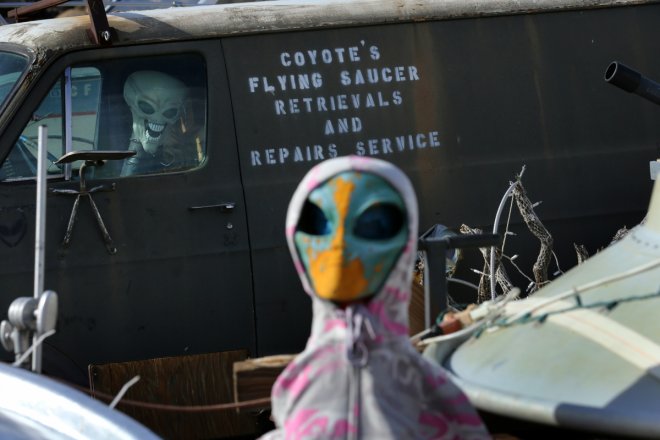
Would trust and intuition be better weapons than artillery and missiles in the eventuality of an alien visitation, something which is predicted to happen as soon as 20 years? Yes, would be the reply from a viewer convinced by Arrival, Hollywood's sci-fi offering of the year.
In fact, as the movie goes, in such an eventuality of green monsters dropping in, it is a linguist who would be Earth's best bet. Not the burly US army commander or the spectacled mathematician well-versed in deciphering prime number codes. Gunfire and Fibonacci sequences turn out to be losers where Louise Banks, professor in linguistics manages, using English alphabets, to communicate with the huge 'heptapods' and find the 'purpose' of their visit.
Interpreting the grammar in the smoky logograms stamped on the screen by the creatures and learning it, ends up almost in a rewiring of Louise' brains. The film goes to and fro in time in what could confuse the viewer. But that is where it perhaps lives the core message from the aliens -- that time is not any more linear than language itself is! Symbolically, in trying to intuitively discern the heptapod art, Louise begins to slip at ease from past to future and back. The heptapods have, like in Contact, come to give earthlings a gift and collect a favour in return, some 1000 years later.
Our language is what makes us think the way we do, dream the way we do, in fact makes us what we are. Tough as that is to swallow for those of us outside linguistic studies, it is in sync with the bizarre alien world director Denis Villeneuve weaves for us.
The looming spacecraft, shaped like massive obelisks, turns out to be another world with many dimensions. The earthy visitors find themselves in a realm sans gravity or ups and downs. The vertical becomes horizontal and the end of the passage a screen where the aliens 'arrive' and 'exit' in illusionary style.
Barring that and few scenes of men in hazmat suits to protect against radiation hazards (we do seem to cast our dirty suspicions on aliens) and perplexed experts staring into computer screens and television sets, there is not much of space-based sci-fi here.
Based on the short story 'Story of Your Life' by Ted Chiang, ultimately the movie is more about us humans than aliens. It is about the need for unity and trust among nations. It is about the need to communicate when all links seem to be snapped. Communication between nations. Between different subject experts. Between family members.
It is also about how we look at free will and fate. Would we scramble to change the punctuations and alter life to avert tragedies? Or will we accept life knowing the inevitable bundle of pain and pleasure sure to follow?
Like Nolan's Interstellar set off debates on whether it was the right approach -- to abandon earth and look for new pastures, to even suggest that this is the way out and hence allow the likes of Trump and co to plunder the planet, Arrival focuses on the question of freewill and choice. Why did Louise choose to have a daughter she knew would die of cancer? Using aliens as triggers, the movie turns one to look within and ask a few questions.
Where are they?
But at the level of the aliens, for me it brought back attention to the question: Should we, as Seti (Search for extraterrestrial intelligence) and the million dollar project Breakthrough Listen firmly believe, reach out? Or not, heeding to concerned scientists who have warned against 'asking for trouble'? In a statement issued in 2015, scientists from The University of California, Berkeley and others said, "We know nothing of ETI's intentions and capabilities, and it is impossible to predict whether ETI will be benign or hostile."
Seti has been since few decades engaged in scouring the skies for possible signals from ETIs. Taking it a step further is the Meti program (messaging the ETI) which seeks to send out signals to intelligent life out there. Seth Shostak at Seti believes mankind will soon create computers that can receive a radio transmission from aliens in as less as 20 years.
Given the vast and infinite expanse of the universe, given the billions of galaxies with countless stars and planets in them, it seems logical to expect that at least a few million of them have conditions suitable for life. Or else, as Carl Sagan was wont to say (like the character Ellie in his 1985 film Contact), it would seem like an "awful waste of space".
Looking at the distribution of Earth-like planets in the universe, astronomers believe the average age of these planets is about two billion years older than our Earth. If that is so, there are chances that any life on these planets have had two billion years longer than ours, hence they could be that much ahead of us in evolution. Of course, that is only if life advanced at the same pace as on Earth.
Physicist Stephen Hawking believes it could be dangerous to listen to such advanced aliens, let alone contacting them. He has likened messages from them to a Trojan horse where allowing it into our minds could kill us!
But where are they? Why if, as Sagan pointed out, the molecules of life are scattered all over the wide cosmos, has life not sprouted and galloped in 14 billion years since the Big Bang? Could it be, as he predicted in a pessimistic mood perhaps, that any advanced civilisation would eventually get wiped out by technology it invented (a la nuclear back home)?
Or, could it be as Hawking suggests that to such advanced civilisations, we could seem as insignificant as bacteria seems to us? Hence, not worth bothering about!
Recently, a team from Laval university in Quebec hit headlines with their study that suggested possible signs of extra-intelligent life during a survey of the sky. They observed specific signal modulations in just 234 out of the 2.5 million stars, with the narrow spectral range centred near the spectral type of the sun.
Alien transmission?
Writing in the journal Publications of the Astronomical Society of the Pacific, under the title 'Discovery' of peculiar periodic spectral modulations in a small fraction of solar type stars' the scientists however acknowledge that 'extraordinary claims require extraordinary evidence' by way of independent verification by other groups.
Earlier 'evidences' of signals from aliens have turned out to be pulsars and the like which also emit periodic radiations.
Then there is the 250,000 year old piece of aluminium excavated in Romania suggesting alien visitors back then. Aluminium was made by humans a mere 200 years ago. Yet another contender for alien presence is the star Tabby (in the constellation Cygnus) with its abnormal dip in brightness which scientists say cannot be credited to orbiting planets or anything but a megastructure put up by aliens!
Look at it as you like. That we are unique and special in this seemingly endless world. If so, why and what is our mission? Or, simply that we are alone in the vastness of space. Alone, with each other. Why? Why did life not evolve in a billion other places? We must also remember that we are infants in the cosmological scale of 14 billion years. Modern homo sapiens emerged a mere 200,000 years ago in Africa.
Could it be that we are not looking with the right tools? Perhaps an evolved life form can be perceived with an evolved consciousness rather than a wider telescope array? Perhaps, at that level we could well be the aliens, existing here, there and everywhere at the same time and all times. As heptapods, green humanoid ETs, machines or form-changing entities!
Arrival points to a need to change our attitude in seeking the intelligent ET. From suspicion to communication. From aggression to empathy. From control to trust.









